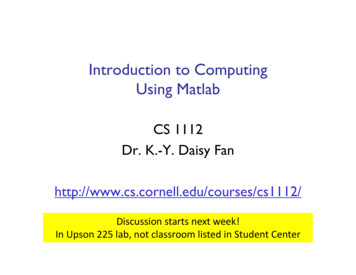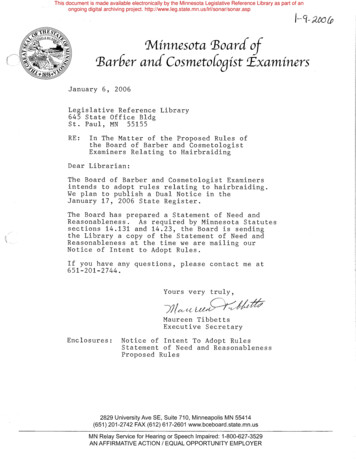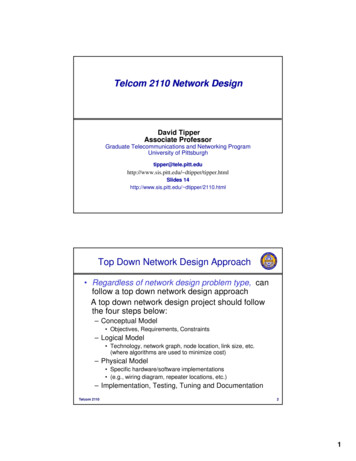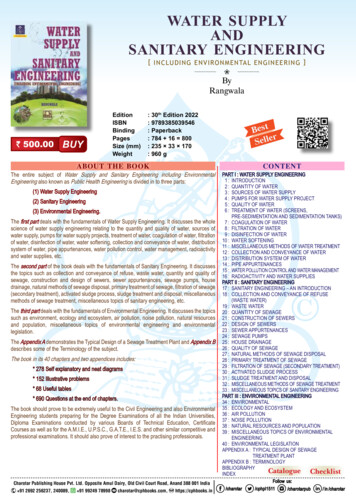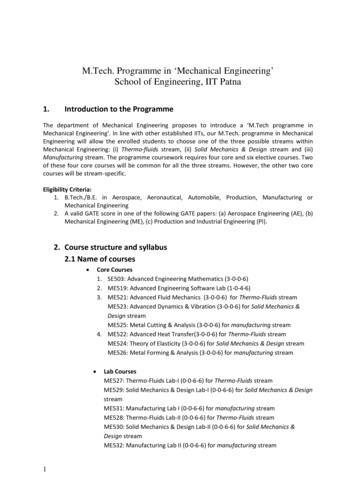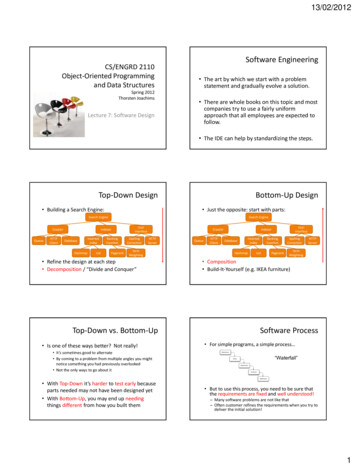
Transcription
13/02/2012CS/ENGRD 2110Object-Oriented Programmingand Data StructuresSpring 2012Thorsten JoachimsLecture 7: Software DesignSoftware Engineering The art by which we start with a problemstatement and gradually evolve a solution. There are whole books on this topic and mostcompanies try to use a fairly uniformapproach that all employees are expected tofollow. The IDE can help by standardizing the steps.Top-Down Design Building a Search Engine:Bottom-Up Design Just the opposite: start with parts:Search EngineCrawlerQueueHTTPClientSearch rawlerHTTPServerTermWeighting Refine the design at each step Decomposition / “Divide and Conquer”Top-Down vs. Bottom-Up Is one of these ways better? Not really! It’s sometimes good to alternate By coming to a problem from multiple angles you mightnotice something you had previously overlooked Not the only ways to go about it With Top-Down it’s harder to test early becauseparts needed may not have been designed yet With Bottom-Up, you may end up needingthings different from how you built ngCorrectionHTTPServerTermWeighting Composition Build-It-Yourself (e.g. IKEA furniture)Software Process For simple programs, a simple process “Waterfall” But to use this process, you need to be sure thatthe requirements are fixed and well understood!– Many software problems are not like that– Often customer refines the requirements when you try todeliver the initial solution!1
13/02/2012Incremental & Iterative Deliver versions of the system in several small cycles:TESTING ANDTEST-DRIVEN DEVELOPMENT Recognizes that for some settings, softwaredevelopment is like gardening. You plant seeds see what does well then replace theplants that did poorly.The Importance of Testing Famous last words– “Its all done, I just have not tested it yet”. Many people– Write code without being sure it will work– Press run and pray– If it fails, they change something random Never work, and ruins weekend social plans.The Example A collection class SmallSet containing up to N objects (hence “small”) typical operations:addadds itemcontainsis item in the set?size# items we’ll implement add(), size() Test-Driven Development!Test Driven Development We’ll go about in small iterations1.add a test2.run all tests and watch the new one fail3.make a small change4.run all tests and see them all succeed5.refactor (as needed) We’ll use JUnitJUnit What do JUnit tests look like?SmallSet.javapackage edu.cornell.cs.cs2110;SmallSetTest.javapackage edu.cornell.cs.cs2110;public class SmallSet {.}import org.junit.Test;import static org.junit.Assert.*;public class SmallSetTest {@Test public void testFoo() {SmallSet s new SmallSet();.assertTrue(.);}@Test public void testBar() {.}}2
13/02/2012A List of Tests We start by thinking about how to test,not how to implement size 0 on empty setsize N after adding N distinct elementsadding element already in set doesn’t change sizethrow exception if adding too many. Each test verifies a certain “feature”A First Test We pick a feature and test it:SmallSetclass SmallSet {}SmallSetTestclass SmallSetTest {@Test public void testEmptySetSize() {SmallSet s new SmallSet();assertEquals(0, s.size());}} This doesn’t compile: size()is undefined But that’s all right: we’ve started designing theinterface by using itRed Bar A test can be defined before the code is writtenGreen Bar What’s the simplest way to make a test pass?SmallSetclass SmallSet {public int size() {return 0;}}SmallSetclass SmallSet {public int size() {return 42;}} Running the testyields a red barindicating failure: “Fake it till you make it” Re-running yields the legendary JUnit GreenBar: If we add the size function and re-run the thetest, it works! Move on with the next featureAdding Items To implement adding items, we first test for it:SmallSetTestclass SmallSetTest {@Test public void testEmptySetSize() .@Test public void testAddOne() {SmallSet s new SmallSet();s.add(new Object());assertEquals(1, s.size());}} add() is undefined, so to run the test wedefine it: SmallSetpublic int size() .Adding Items The test now fails as expected: It seems obvious we need to count the numberof items: SmallSetprivate int size 0;public int size() {return 0;return size;}public void add(Object o) { size;} And we get a green bar:public void add(Object o) {}3
13/02/2012Adding Something Again So what if we added an item already in the set?SmallSetTestclass SmallSetTest {@Test public void testEmptySetSize() .@Test public void testAddOne() .@Test public void testAddAlreadyInSet() {SmallSet s new SmallSet();Object o new Object();s.add(o);s.add(o);assertEquals(1, s.size());}} As expected, the test fails.Remember that Item?. We need to remember which items are in theset. SmallSetprivate int size 0;public static final int MAX 10;private Object items[] new Object[MAX];.public void add(Object o) {for (int i 0; i MAX; i ) {if ( items[i] o) {return;}}items[ size] o; size;} All tests pass, so we can refactor that loop.RefactoringToo Many FOR-loop doesn’t “speak to us” as it could. What if we try to add more than SmallSet can hold?SmallSet (before)public void add(Object o) {for (int i 0; i MAX; i ) {if ( items[i] o) {return;}}items[ size] o; size;}SmallSet (after)private boolean inSet(Object o) {for (int i 0; i MAX; i ) {if ( items[i] o) {return true;}}return false;}public void add(Object o) {if (!inSet(o)) {items[ size] o; size;}} All tests still pass, so we didn’t break it!Size Matters We first have add() check the size,SmallSetpublic void add(Object o) {if (!inSet(o) && size MAX) {items[ size] o; size;}} . re-run the tests, check for green,define our own exception.SmallSetFullExceptionpublic class SmallSetFullException extends Error {} . re-run the tests, check for green,and.SmallSetTest.@Test public void testAddTooMany() {SmallSet s new SmallSet();for (int i 0; i SmallSet.MAX; i ) {s.add(new Object());}s.add(new Object());} The test fails with an error:ArrayIndexOutOfBoundsException We know why this occurred, but it should botherus: “ArrayIndex” isn’t a sensible error for a “set”Testing for Exceptions . finally test for our exception:SmallSetTest@Test public void testAddTooMany() {SmallSet s new SmallSet();for (int i 0; i SmallSet.MAX; i ) {s.add(new Object());}try {s.add(new Object());fail(“SmallSetFullException expected”);}catch (SmallSetFullException e) {}} The test fails as expected,so now we fix it.4
13/02/2012Testing for Exceptions . so now we modify add() to throw:After all Tests are Passed Is the code is correct?– Yes, if we wrote the right tests. Is the code efficient?SmallSetpublic void add(Object o) {if (!inSet(o) && size MAX) {if ( size MAX) {throw new SmallSetFullException();}items[ size] o; size;}}– Probably used simplest solution first.– Replace simple data structures with better data structures.– New ideas on how to compute the same while doing less work. Is the code readable, elegant, and easy to maintain?– It is very common to find some chunk of working code, make a replica, andthen edit the replica.– But this makes your software fragile Later changes have to be done on all instances, or some become inconsistent– Duplication can arise in many ways: All tests now pass, so we’re done: constants (repeated “magic numbers”)code vs. commentwithin an object’s state.“DRY” Principle Don’t Repeat Yourself A nice goal is to have each piece ofknowledge live in one place But don’t go crazy over it– DRYing up at any cost can increase dependenciesbetween code– “3 strikes and you refactor” (i.e., clean up)Simple Refactoring Renaming variables, methods, classes for readability. Explicitly defining constants:public double weight(double mass) {return mass * 9.80665;}public double totalArea() {.// now add the circlearea PI * pow(radius,2);.}public double totalArea() {.area circleArea(radius);.}public double weight(double mass) {return mass * GRAVITY;}– If your application later gets used as part of a Nasa missionto Mars, it won’t make mistakes– Every place that the gravitational constant shows up in yourprogram a reader will realize that this is what she is lookingat– The compiler may actually produce better codeExtract Method A comment explaining what is being doneusually indicates the need to extract a methodstatic final double GRAVITY 9.80665;Extract Method Simplifying conditionals with ExtractMethodbeforeif (date.before(SUMMER START) date.after(SUMMER END)) {charge quantity * winterRate winterServiceCharge;}else {charge quantity * summerRate;}private double circleArea(double radius) {return PI * pow(radius, 2);}after One of the most common refactoringsif (isSummer(date)) {charge summerCharge(quantity);}else {charge winterCharge(quantity);}5
13/02/2012Review Started with a “to do” list of tests / features could have been expandedas we thought of more tests / features Added features in small iterationsIs testing obligatory? When you write code in professional settingswith teammates, definitely!– In such settings, failing to test your code just meansyou are inflicting errors you could have caught onteammates!– People get fired for this sort of thing!– So in industry test or perish! But what if code is just “for yourself”? “a feature without a test doesn’t exist”Fixing a Bug What if after releasing we found a bug?– Testing can still help you debug, and if you go to thetrouble of doing the test, JUnit helps you “keep it” forre-use later.– “I have never written a program that was correctbefore I tested and debugged it.” Prof. JoachimsA bug can reveal a missing test but can also reveal that the specification wasfaulty in the first place, or incomplete– Code “evolves” and some changing conditions cantrigger buggy behavior– This isn’t your fault or the client’s fault but fingerpointing is common Great testing dramatically reduces bug rates– And can make fixing bugs way easier– But can’t solve everything: Paradise isn’t attainable inthe software industryFamous last words: “It works!”Reasons for TDD By writing the tests first, we test the testsdesign the interface by using itensure the code is testableensure good test coverage By looking for the simplest way to maketests pass, the code becomes “as simple as possible, but nosimpler” may be simpler than you thought!Not the Whole Story There’s a lot more worth knowing about TDD What to test / not to test» e.g.: external libraries? How to refactor tests Fixtures Mock Objects Crash Test Dummies .Beck, Kent: Test-Driven Development: By Example6
13/02/2012How people write really big programs When applications are small, you can understandevery element of the system But as systems get very large and complex, youincreasingly need to think in terms of interfaces,documentation that defines how modules work,and your code is more fragmented This forces you into a more experimental styleJunit testing isn’t enough For example, many systems suffer from “leaks”– Such as adding more and more objects to an ArrayList– The amount of memory just grows and grows Some systems have issues triggered only in bigdeployments, like cloud computing settings Sometimes the application “specification” was flawed, anda correct implementation of the specification will lookerroneous to the end user But a thorough test plan can reveal all such problemsWhy is Q/A a cycle? Each new revision may fix bugs but could alsobreak things that were previously working Moreover, during the lifetime of a complexapplication, new features will often be added andthose can also require Q/A Thus companies think of software as having a verylong “life cycle”. Developing the first version isonly the beginning of a long road!Testing is a part of that style! Once you no longer know how big parts of thesystem even work (or if they work), you insteadbegin to think in terms of– Code you’ve written yourself. You tested it and knowthat it works!– Modules you make use of. You wrote experiments toconfirm that they work the way you need them towork– Tests of the entire complete system, to detect issuesvisible only when the whole thing is running or onlyunder heavy loadThe Q/A cycle Real companies have quality assurance teams They take the code and refuse to listen to all thelong-winded explanations of why it works Then they do their own, independent, testing And then they send back the broken code with a longlist of known bugs! Separating development from Q/A really helpsEven with fantastic Q/A The best code written by professionals will still havesome rate of bugs– They reflect design oversights, or bugs that Q/A somehowdidn’t catch– Evolutionary change in requirements– Incompatibilities between modules developed by differentpeople, or enhancements made by people who didn’t fullyunderstand the original logic So never believe that software will be flawless Our goal in cs2110 is to do as well as possible In later CS courses we’ll study “fault tolerance”!7
-Such as adding more and more objects to an ArrayList -The amount of memory just grows and grows Some systems have issues triggered only in big deployments, like cloud computing settings Sometimes the application "specification" was flawed, and a correct implementation of the specification will look -
